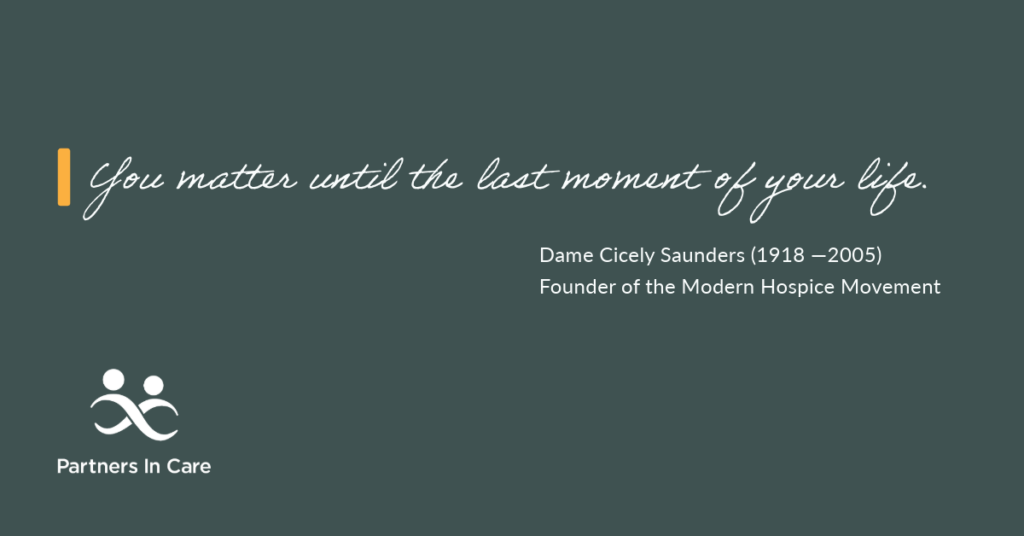By Robin Emerson, Partners In Care Volunteer

For the past year and a half, I’ve visited a woman, now 77, diagnosed with a degenerative condition that causes changes in motor and language skills as areas of the brain atrophy and nerve cells die. “I’m a prisoner in my body,” Linda told me. One day I arrived to find a wheelchair covered with a shawl and pushed into a corner of her bedroom where it stayed untouched for months. “I don’t like to look at it,” she said.
It was through a chance encounter that I first heard of Partners In Care. I knew little about hospice at the time, but in conversation with a woman who worked for Partners In Care, a door to a new way of living with dying was opened. After filling out an application, I met with Terri Kelly, one of the volunteer coordinators. Over coffee, she told me a little about her own family’s experience with hospice and described the opportunities available to volunteers. When she mentioned Transitions, the Partners In Care program for people with life-limiting illnesses, I found myself drawn to the idea of becoming a client visitor. I remember asking Terri when the interview would be scheduled. She laughed and said, “This was the interview.”
Before settling into a permanent assignment, I wanted to learn about the organization. A volunteer with many years of experience took me along with her to visit a woman in a memory care facility. When Terri asked if I could make a respite visit, I drove north from Bend into ranch country to spend a few hours with a 101-year-old woman bedridden in her daughter’s home. Over time, I grew familiar with Hospice House. I learned how to welcome and assist arriving guests, ran an emergency errand to pick up pain medication, and sat with a woman I met only once, but will never forget. She lay dozing under a handmade quilt in a quiet, light-filled room at Hospice House. We didn’t speak, but as I got up to leave, she opened her eyes, smiled, and then closed them again.
I was introduced to Linda and her daughter by Laurie Slye, her nurse case manager. It was a hot summer day in August 2022. A walker—along with a measure of apprehension—had just been delivered. Linda told me she would like to practice while I was there. Each week we made our way up and down the third floor hallway. She grew more confident. One day she was ready to confront the elevator’s corrugated metal threshold. Soon after, she navigated the bumps and depressions in the sidewalk to make a circuit of the building. “I just made it over three obstacles without falling,” she said. “I feel it—success!” Some days we focused on her physical therapy routine: count, stretch, lift, breathe. “Alexa, play march music,” she would say.
Over the course of 2023, I watched the progression of losses. The pace of our conversations slowed as it became more difficult for Linda to string sentences together. Her sofa was sold and a recliner brought in. Then one day — I didn’t expect it — a wheelchair was parked next to the recliner.
Hello and goodbye, yes and no, please and thank you have never been more simple or felt more real. Each moment is precious.
Robin EMERSON
Until I met Linda, I hadn’t known how humor can soften the rough edges of decline. Not long ago, she demonstrated a new physical therapy exercise. I watched as she molded her stiffened fingers —fingers that can no longer hold a fork or pick up a sandwich— into a fist. “Hold up your hand,” she ordered. Then, amidst much laughter, she pushed into my palm with a firm, steady pressure that bent me backwards and held me there. I don’t get punched that often and didn’t know that a punch could be hilarious.
Although I can’t transfer Linda from her recliner to the wheelchair, help her use the toilet or take a shower, I can refill her sippy cup, water the plants on the windowsill, and find the phone charger lost between the mattress and the box spring. I can brush her hair, put chapstick on her lips, and clean her glasses. I take dictation if she wants to send a graduation card to a granddaughter or write a letter to an old friend. We almost always read and pray together before we part.
I’ve followed Linda from a retirement home into assisted living where she was eventually placed on palliative care and then home hospice. She was moved to an advanced care facility where she now lives with four other patients. Her nurse, social worker, chaplain, and an end-of-life doula see her on a regular basis. As a member of the hospice team, each week I document our visit. I do my best to convey what Linda and I have done or talked about that might be helpful to know.
What is more difficult to document is the admiration I feel for Linda— and the love that’s grown between us. A lot gets stripped away. Hello and goodbye, yes and no, please and thank you have never been more simple or felt more real. Each moment is precious.
I can brush her hair, put chapstick on her lips, and clean her glasses. I take dictation if she wants to send a graduation card to a granddaughter or write a letter to an old friend.
Robin emerson
*Names shared with permission. Story originally authored May 2023.
